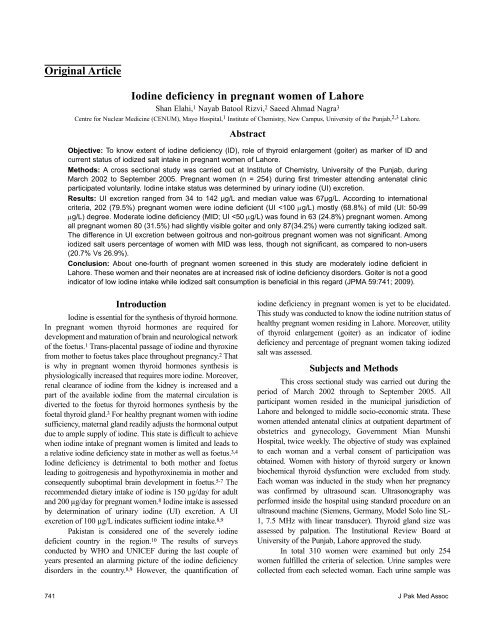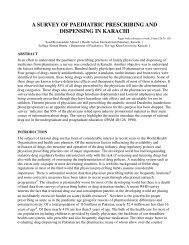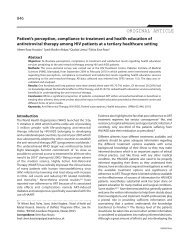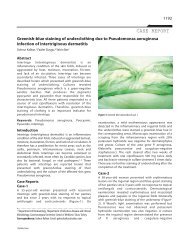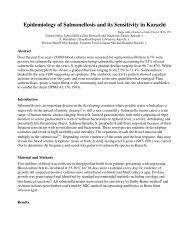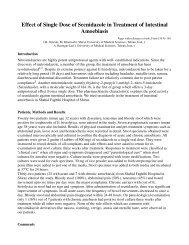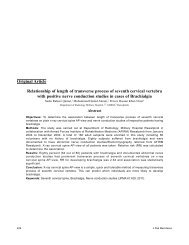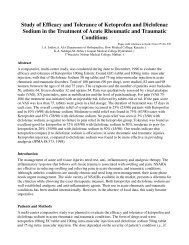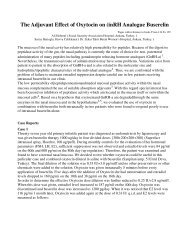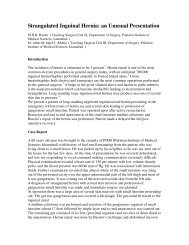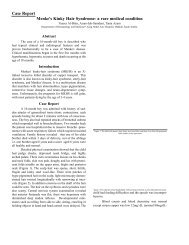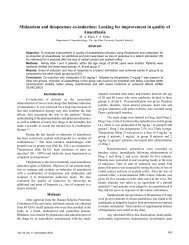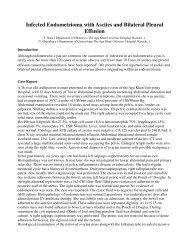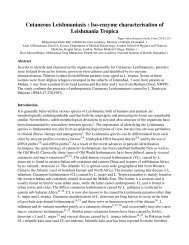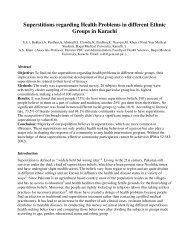Pages - Nov-09--1:Pages - Nov-09--1.qxd.qxd - Journal of Pakistan ...
Pages - Nov-09--1:Pages - Nov-09--1.qxd.qxd - Journal of Pakistan ...
Pages - Nov-09--1:Pages - Nov-09--1.qxd.qxd - Journal of Pakistan ...
Create successful ePaper yourself
Turn your PDF publications into a flip-book with our unique Google optimized e-Paper software.
Original Article<br />
Iodine deficiency in pregnant women <strong>of</strong> Lahore<br />
Shan Elahi, 1 Nayab Batool Rizvi, 2 Saeed Ahmad Nagra 3<br />
Centre for Nuclear Medicine (CENUM), Mayo Hospital, 1 Institute <strong>of</strong> Chemistry, New Campus, University <strong>of</strong> the Punjab, 2,3 Lahore.<br />
Introduction<br />
Iodine is essential for the synthesis <strong>of</strong> thyroid hormone.<br />
In pregnant women thyroid hormones are required for<br />
development and maturation <strong>of</strong> brain and neurological network<br />
<strong>of</strong> the foetus. 1 Trans-placental passage <strong>of</strong> iodine and thyroxine<br />
from mother to foetus takes place throughout pregnancy. 2 That<br />
is why in pregnant women thyroid hormones synthesis is<br />
physiologically increased that requires more iodine. Moreover,<br />
renal clearance <strong>of</strong> iodine from the kidney is increased and a<br />
part <strong>of</strong> the available iodine from the maternal circulation is<br />
diverted to the foetus for thyroid hormones synthesis by the<br />
foetal thyroid gland. 3 For healthy pregnant women with iodine<br />
sufficiency, maternal gland readily adjusts the hormonal output<br />
due to ample supply <strong>of</strong> iodine. This state is difficult to achieve<br />
when iodine intake <strong>of</strong> pregnant women is limited and leads to<br />
a relative iodine deficiency state in mother as well as foetus. 3,4<br />
Iodine deficiency is detrimental to both mother and foetus<br />
leading to goitrogenesis and hypothyroxinemia in mother and<br />
consequently suboptimal brain development in foetus. 5-7 The<br />
recommended dietary intake <strong>of</strong> iodine is 150 µg/day for adult<br />
and 200 µg/day for pregnant women. 8 Iodine intake is assessed<br />
by determination <strong>of</strong> urinary iodine (UI) excretion. A UI<br />
excretion <strong>of</strong> 100 µg/L indicates sufficient iodine intake. 8,9<br />
<strong>Pakistan</strong> is considered one <strong>of</strong> the severely iodine<br />
deficient country in the region. 10 The results <strong>of</strong> surveys<br />
conducted by WHO and UNICEF during the last couple <strong>of</strong><br />
years presented an alarming picture <strong>of</strong> the iodine deficiency<br />
disorders in the country. 8,9 However, the quantification <strong>of</strong><br />
Abstract<br />
Objective: To know extent <strong>of</strong> iodine deficiency (ID), role <strong>of</strong> thyroid enlargement (goiter) as marker <strong>of</strong> ID and<br />
current status <strong>of</strong> iodized salt intake in pregnant women <strong>of</strong> Lahore.<br />
Methods: A cross sectional study was carried out at Institute <strong>of</strong> Chemistry, University <strong>of</strong> the Punjab, during<br />
March 2002 to September 2005. Pregnant women (n = 254) during first trimester attending antenatal clinic<br />
participated voluntarily. Iodine intake status was determined by urinary iodine (UI) excretion.<br />
Results: UI excretion ranged from 34 to 142 µg/L and median value was 67µg/L. According to international<br />
criteria, 202 (79.5%) pregnant women were iodine deficient (UI
collected in an aseptic plastic container, sealed and labeled with<br />
identification code. UI concentration was determined at<br />
laboratories <strong>of</strong> Institute <strong>of</strong> Chemistry, University <strong>of</strong> the Punjab<br />
Lahore by Sandell-Kolth<strong>of</strong>f reaction (modified) as<br />
recommended by WHO/UNICEF/ICCIDD (2001). 8 Urine was<br />
digested with ammonium persulfate and iodide, acting as<br />
catalyst in the reduction <strong>of</strong> ceric ammonium sulfate (yellow) to<br />
cerous form (colourless), was determined by rate <strong>of</strong> colour<br />
disappearance. Measurements were carried out in duplicates.<br />
Results were expressed as microgam <strong>of</strong> iodine per liter <strong>of</strong> urine<br />
(µg/L). The lower detection limit for the assay was 0.15µg/L.<br />
The mean coefficient <strong>of</strong> variance (CV) for iodine concentration<br />
0.18 µg/L was 16.2%, for 0.78 µg/L was 7.1% and for 1.3 µg/L<br />
was 5.5%. The WHO/UNICEF/ICCIDD criteria were used to<br />
classify the pregnant women as taking sufficient, mildly<br />
deficient and moderately deficient iodine. 8<br />
Results are presented as means (±SD), median or<br />
otherwise specified. Data were analyzed using statistical<br />
package for social sciences (SPSS) [version 13.0 for Windows<br />
supplied by SPSS Inc. 2003, Mapinfo Corp. NY, USA]. Group<br />
means were compared by Student's t test. Chi-square test was<br />
used to compare frequencies among different groups. All<br />
statistical tests were considered statistically significant<br />
whenever P< 0.05.<br />
Results<br />
UI excretion levels showed a wide individual scatter<br />
and ranged from 34-142 µg/L (70.7 ± 26.5 µg/L) in pregnant<br />
women. Mean and median UI was 70.7 µg/L and 67.0 µg/L<br />
respectively. The distribution <strong>of</strong> UI and iodine intake status <strong>of</strong><br />
pregnant women according to WHO criteria is shown in the<br />
Table-1. Most <strong>of</strong> the pregnant woman (n =220; 79.5%) had UI<br />
excretion below 100 µg/L. Among them 139 were mildly while<br />
63 (24.8 percent <strong>of</strong> total sample) were moderately iodine<br />
deficient (UI< 50 µg/L).<br />
Among pregnant women 87 (34.2 percent) were<br />
currently taking iodized salt and 80 (31.5 percent) women had<br />
slightly visible goiter. A comparison <strong>of</strong> UI concentration<br />
between different groups <strong>of</strong> pregnant women based on iodized<br />
salt use and presence <strong>of</strong> goiter is shown in Table-2. The<br />
difference in mean UI excretion was not significantly different<br />
in pregnant women taking or not-taking iodized salt. However,<br />
percentage <strong>of</strong> women with moderate iodine deficiency was<br />
reduced, though did not reach a significant level (P=0.06),<br />
among iodized salt user as compared to non-user. Similarly the<br />
difference in mean UI concentration between goitrous and nongoitrous<br />
pregnant women was not significant (P=0.08). Among<br />
women with moderate iodine deficiency only 18 (28.5 percent)<br />
had goiter while 9 (17.3 percent) women with sufficient iodine<br />
intake also had goiter. This difference was not significant<br />
(P=0.36).<br />
Discussion<br />
Our results indicated that most <strong>of</strong> the pregnant women<br />
included in this study had iodine intake well below the<br />
recommended limit. 8 With median UI excretion 67.0 µg/L, the<br />
cohort <strong>of</strong> the pregnant women under study was moderately<br />
iodine deficient. 11 A study in Lahore has already reported mild<br />
to moderate iodine deficiency, as estimated by cord blood TSH,<br />
in pregnant women. 12 Our results are in accordance to those<br />
reported by National Nutrition Survey 2001-2002 <strong>of</strong><br />
Government <strong>of</strong> <strong>Pakistan</strong>. According to that survey mean UI<br />
excretion in pregnant women was 69.2 ± 78.9 µg/L and 76<br />
percent women had UI100 µg/L ( >150 µg/day) -20.5 (100-142)<br />
Mildly Deficient 139 68.1 ± 11.8<br />
50 - 99 µg/L (75-149 µg/day) -54.7 (50-92)<br />
Moderately Deficient 63 41.1 ± 03.3<br />
< 50 µg/L (30-74 µg/day) -24.8 (34-48)<br />
* WHO/UNICEF/ICCIDD (2001)<br />
Table-2: Iodine intake status <strong>of</strong> different<br />
sub-groups <strong>of</strong> pregnant women.<br />
Factor Sub-group UI No. <strong>of</strong><br />
women<br />
(No. <strong>of</strong> women) (µg/L) with UI< 50<br />
µg/L (%)<br />
Presence <strong>of</strong> Goiter Goitrous (80) 66.7 ± 23 19 (23.7)<br />
Non-goitrous (174) 72.5 ± 27.8 44 (25.3)<br />
Iodine Salt Intake User (87) 75.4 ± 27.3 18 (20.7)<br />
Non-User (167) 68.8 ± 26 45 (26.9)<br />
noteworthy difference: no women in this cohort had severe<br />
iodine deficiency (UI < 20 µg/L) while about 36.5 percent<br />
mothers were reported to have severe iodine deficiency in<br />
above mentioned survey. The reason may be in the difference<br />
in study population. Our study was based on urban women <strong>of</strong><br />
only one city but Nutrition Survey recruited pregnant women<br />
Vol. 59, No. 11, <strong>Nov</strong>ember 20<strong>09</strong> 742
from selected urban and rural areas <strong>of</strong> <strong>Pakistan</strong>.<br />
Iodine intake status is ethnic specific and is most likely<br />
because <strong>of</strong> differences in dietary behaviours among different<br />
groups. 13 The dietary content <strong>of</strong> iodine in typical <strong>Pakistan</strong>i diet<br />
is reported to be 60 µg/day. 14 Akhter at al (2004) has reported<br />
that excluding the iodine intake from sea food and water, this<br />
daily intake is further reduced to 40 µg/day. This figure is 3.8<br />
times lower than recommended for adult subject (150 µg/d).<br />
The low iodine content <strong>of</strong> the <strong>Pakistan</strong>i diet might be due to the<br />
dietary habits <strong>of</strong> the <strong>Pakistan</strong>i people, to diet composition<br />
(mainly a lack <strong>of</strong> sea food), to the natural environment <strong>of</strong> the<br />
country (lack <strong>of</strong> iodine in the <strong>Pakistan</strong>i soil) and to iodine<br />
losses during cooking. 15<br />
The history <strong>of</strong> iodine availability prior to and during<br />
pregnancy is determinant <strong>of</strong> UI excretion. 16 It is proposed that<br />
depending upon dietary iodine intake each women has her own<br />
specific UI-threshold termed "iodostat" during pregnancy. 17<br />
The increased renal clearance <strong>of</strong> iodine above the UI-threshold<br />
results in increased iodine loss. This UI-threshold is masked at<br />
higher iodine intakes but in iodine deficiency lead to negative<br />
iodine balance and thyroid depletion. This loss is compensated<br />
by increased thyroid volume to allow for more iodine storage. 18<br />
The existence <strong>of</strong> this compensatory mechanism to <strong>of</strong>fset<br />
increased iodine loss is an adaptation to ensure the retention <strong>of</strong><br />
extra iodine during gestation. Thus increased thyroid volume<br />
(goiter) during pregnancy indirectly indicates iodine<br />
deficiency. About 31 percent <strong>of</strong> pregnant women <strong>of</strong> this cohort<br />
had slightly visible goiter. However, we observed goiter in only<br />
28 percent pregnant women who were moderately iodine<br />
deficient. Moreover, no significant difference in UI excretion<br />
between goitrous and non-goitrous pregnant women was<br />
observed. Thus, existence <strong>of</strong> slightly visible goiter in pregnant<br />
women <strong>of</strong> this cohort does not indicate low iodine intake and<br />
was independent <strong>of</strong> UI excretion. The increase in thyroid<br />
volume may also be due to protein malnutrition as reported in<br />
Indian pregnant women by Sakinah et al. 19<br />
Present study revealed that only 34 percent pregnant<br />
women were taking iodized salt. An investigation from a<br />
neighboring city, Faisalabad, reported that among pregnant<br />
women only 6 percent were taking iodized salt. 20 These figures<br />
are not impressive and warrant the recognition <strong>of</strong> obstacles to<br />
on going iodine supplementation program <strong>of</strong> Government <strong>of</strong><br />
<strong>Pakistan</strong>. This study indicated that iodized salt intake improved<br />
the iodine intake status <strong>of</strong> pregnant women. Iodine sufficiency<br />
can be achieved only through mandatory iodine<br />
supplementation <strong>of</strong> pregnant women. Maternal iodine<br />
sufficiency is necessary as recent investigations had shown that<br />
foetal brain formation is the main target <strong>of</strong> iodine deficiency<br />
that is affected by maternal thyroid status during gestation. 6,7<br />
A shortcoming <strong>of</strong> this study was that <strong>of</strong> small sample<br />
size restricted to one hospital only that did not made it<br />
representative <strong>of</strong> Lahore City. Further, large studies are needed<br />
to elucidate iodine and thyroid hormone deficiency in pregnant<br />
women and its complications like pregnancy-induced<br />
hypertension, placenta abruption, foetal distress, postpartum<br />
haemorrhage, postpartum depression and major complications<br />
at delivery. These aspects <strong>of</strong> reproductive health requires<br />
immediate attention.<br />
References<br />
1. Bernal J, Guadano-Ferraz A, Morte B. Perspectives in the study <strong>of</strong> thyroid<br />
hormone action on brain development and function. Thyroid 2003; 13: 1005-12.<br />
2. Vulsma T, Gons MH and de Vijlder JJ. Maternal fetal transfer <strong>of</strong> thyroxine in<br />
congenital hypothyroidism due to a total organification defect or thyroid agenesis<br />
N Engl J Med 1989; 321: 13-6.<br />
3. Glinoer D The regulation <strong>of</strong> thyroid function in pregnancy: pathways <strong>of</strong> endocrine<br />
adaptation from physiology to pathology. Endocr Rev 1997; 18: 404-33.<br />
4. Caron PHM, Bazzi S, Dufor A, Faure G, Ghandour I, Lauzu P, et al. Urinary iodine<br />
excretion during normal pregnancy in healthy women living in the southwest <strong>of</strong><br />
France: correlation with maternal thyroid parameters. Thyroid 1997; 7: 749-54.<br />
5. Casey BM, Dashe JS, Wells CE, McIntire DD, Byrd W, Leveno KJ, et al.<br />
Subclinical hypothyroidism and pregnancy outcomes. Obstet Gynecol 2005; 105:<br />
239-45.<br />
6. Delange F. Iodine deficiency as a cause <strong>of</strong> brain damage. Postgrad Med J 2001;<br />
77: 217-20.<br />
7. Pop VJ, Brouwers EP, Vader HL, Vulsma T, van Baar AL, de Vijlder JJ. Maternal<br />
hypothyroxinemia during early pregnancy and subsequent child development: a<br />
3-year follow-up study. Clin Endocrinol 2003; 59: 282-8.<br />
8. World Health Organization (WHO)/United Nations Children Fund (UNICEF)/<br />
International Council for Control <strong>of</strong> Iodine Deficiency Disorders (ICCIDD).<br />
Assessment <strong>of</strong> Iodine Deficiency Disorders and Monitoring their Elimination: A<br />
Guide for Programme Managers, WHO/NHD/01.1 2nd ed. Geneva: WHO, 2001.<br />
9. <strong>Pakistan</strong> Institute <strong>of</strong> Development Economics, Micronutrient Laboratories Aga<br />
Khan University Medical Centre and Planning Commission Government <strong>of</strong><br />
<strong>Pakistan</strong>. National Nutrition Survey 2001-2002. Islamabad, 2003.<br />
10. WHO/UNICEF/ICCIDD: Experience in the prevention, control and elimination<br />
<strong>of</strong> iodine deficiency disorders: a regional perspective. Eastern Mediterranean<br />
Health <strong>Journal</strong> 2004; 10: 761-70.<br />
11. Glinoer D, De Nayer P, Bourdoux P, Lemone M, Robyn C, Van Steirteghem A, et<br />
al. Regulation <strong>of</strong> maternal function during pregnancy. Clin Endocrinol Metab<br />
1990; 72: 276-87.<br />
12. Elahi S, Syed Z and Nagra SA. Status <strong>of</strong> iodine deficiency disorders as estimated by<br />
neonatal cord serum thyrotrophin in Lahore, <strong>Pakistan</strong>. Nut Res 2004; 24: 1005-10.<br />
13. Hamrosi MA, Wallace EM, Riley MD. Iodine status in pregnant women living in<br />
Melbourne differs by ethnic group. Asia Pac J Clin Nutr 2005; 14: 27-31.<br />
14. Iyengar GV, Kawamura H, Parr RM, Miah FK, Wang J, Dang HD, et al. Dietary<br />
intake <strong>of</strong> essential minor and trace elements from Asian diets. Food Nutr Bull<br />
2002; 23 (3 Suppl): 124-8.<br />
15. Akhter P, ur-Rehman K, Orfi SD, Ahmad N. Assessment <strong>of</strong> iodine levels in the<br />
<strong>Pakistan</strong>i diet. Nutrition 2004; 20: 783-7.<br />
16. Elnagar BEA, Wide L, Gebre-Medhin M, Karlsson FA. Iodine status, thyroid<br />
function and pregnancy: Study <strong>of</strong> Swedish and Sudanese women. Eur J Clin Nutr<br />
1998; 52: 351-5.<br />
17. Ardawi MSM, Nasrat HA, Mustafa BE. Urinary iodine excretion and maternal<br />
thyroid function during pregnancy and postpartum. Saudi Med J 2002; 23: 413-22.<br />
18. Smyth PP. Variation in iodine handling during normal pregnancy. Thyroid 1999;<br />
9: 637-42.<br />
19. Sakinah SO, Khalid BA, Aishah AB. Racial disparity in the prevalence <strong>of</strong> thyroid<br />
disorder during pregnancy. Ann Acad Med Singapore 1993; 22: 563-6.<br />
20. Saeed M, Yaqub M, Roohi M, Ashraf M. Prophylactic use <strong>of</strong> iodized salt in<br />
pregnancy. Pr<strong>of</strong>essional Med J 2000; 7: 66-9.<br />
743 J Pak Med Assoc


